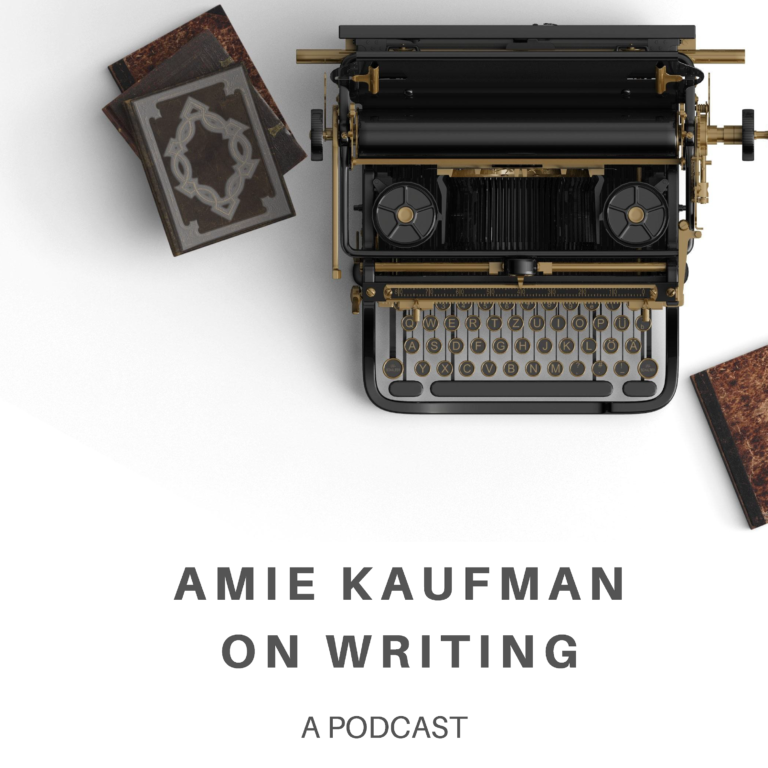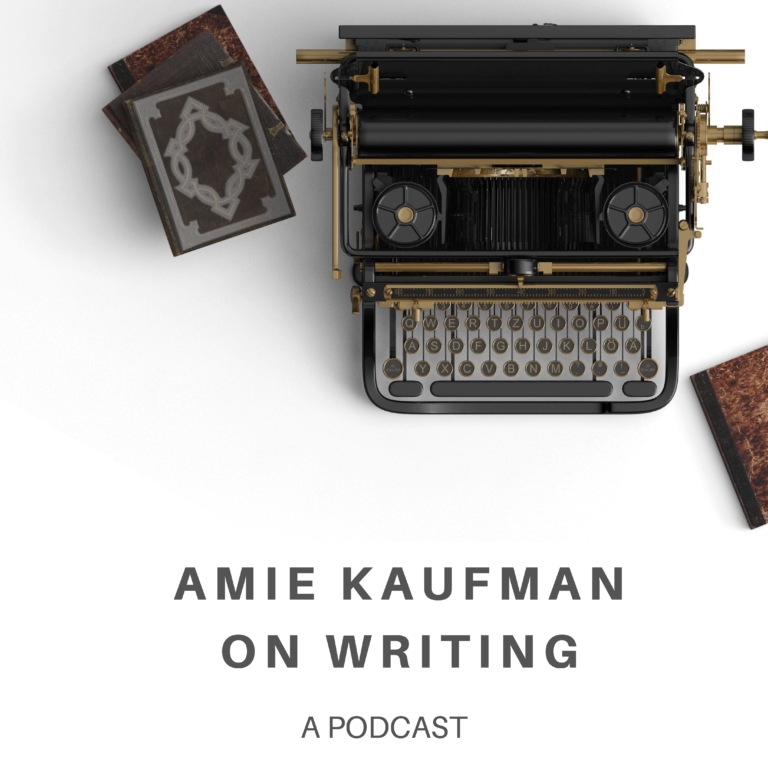Episode 10: Weaving Setting Into Your Story

New York Times and internationally bestselling author Amie Kaufman answers one question each week about writing craft. Full of practical tips and an exercise each week, this is a show for writers, for readers who want a backstage look at how their favourite authors craft their stories, or for creative writing classrooms.
This week we’re going to talk about how you convey it to your reader—because done well, your setting can contribute to the mood of your story, help shape the action, and guide the experience of the reader in ways they don’t even notice. We talked last week about avoiding White Room Syndrome—the feeling that your story could be set anywhere. Let’s talk now about how to weave in those details really well.
You can find a transcript of this episode at my website, where you can also subscribe to my newsletter, get behind-the-scenes peeks at how I write, and any other news about new books, events or the podcast. You can also submit a question for the podcast on my website. You can find me on Twitter or Instagram.

FOLLOW ON APPLE PODCASTS . FOLLOW ON SPOTIFY . FOLLOW ON OVERCAST . FOLLOW ON PODCAST ADDICT
Season 1, Episode 10: Weaving Setting Into Your Story Transcript
Hi, my friends.
Welcome to Amie Kaufman on Writing, a short podcast that answers one question each week about how writers do what they do.
If you’re a writer, or you’re a reader interested in how your favourite authors craft their stories, then you’re in the right place.
This is Season 1, Episode 10: Weaving your setting into your story.
My friends, this is the final episode of season one! It’s been such an adventure, and your response has been amazing, and so much more than I hoped for or ever expected. Thank you for your emails, your reviews and your efforts to spread the word. We’ll definitely be back with season two around the end of this year, and in the meantime I’ve got some really cool surprises for you—they’ll drop into your feed over the next few months, so make sure you’re subscribed, and they’ll turn up like little unexpected presents.
For now, let’s get into it. As always, here’s my friend and producer Kate with this week’s question. Hi Kate, how are you?
Hi Amie, I’m good!
This week’s question is from Hiroko, who says: Can you please talk about how to give more descriptive detail of my story’s setting? I know I’m not meant to start with ‘It was a dark and stormy night,’ but how DO I get it in there naturally?
I’m sure you can see straight away why I paired this question with last week’s. In episode nine we talked about visualizing your story’s setting. This week we’re going to talk about how you convey it to your reader—because done well, your setting can contribute to the mood of your story, help shape the action, and guide the experience of the reader in ways they don’t even notice. We talked last week about avoiding White Room Syndrome—the feeling that your story could be set anywhere. Let’s talk now about how to weave in those details really well.
As Hiroko has absolutely correctly identified, what we’re trying to avoid here—just as when we were weaving in our worldbuilding—is the info dump. There’s a famous quote from Anton Chekhov about this very thing. He says: “Don’t tell me the moon is shining; show me the glint of light on broken glass.”
What he’s talking about is the difference between saying it was a dark and stormy night, and being buffeted by sheets of rain coming in sideways, the wind tangling your hair across your face so you get a mouthful of it—you long-haired listeners know what I’m talking about—and the burning chill of losing circulation in your fingers and toes.
Let’s go through three different ways you can weave your setting through your story.
The first is to tap into all five senses—don’t just describe what your characters see (and if you do, remember that glint of moonlight), but think about their senses of hearing, taste, touch and smell as well.
Obviously you don’t want a catalogue of all these things—what you’re looking for is the one or two that will bring everything else alive.
Think of the chirp of cicadas and the smell of a barbecue cooking—I didn’t tell you anywhere about what your setting looks like, but I bet you just started to fill in the details.
What about the smell of sunscreen and the screech of seagulls? (You can probably tell I’m missing summer as I write this.)
What about leaves crunching under your feet as you walk? You’re not in a white room now, are you?
So that’s technique number one—going, selectively, to all five senses.
Option two is to think about what’s specific to this moment in time—know what time of day it is during this scene, or what the weather is. Think about the difference between a crowded restaurant during evening rush hour, and the quiet of a mid-afternoon, when maybe one other table is occupied.
That difference influences so many things: the noise around you, whether there’s a sense you’re on a clock, how often the staff might interrupt you, how quick or quiet or private or public the scene feels.
A frantic business dinner or a date in a restaurant where you can barely hear the other person are a world away from a slow, awkward conversation in a mostly-empty café, with an awareness that the waitress can probably hear you, and that other people have places to be at this time of day, even though you don’t. You can make your pick, depending on what outcome you’d like.
Technique number three is to borrow a trick from our worldbuilding—remember that one of the ways to show your worldbuilding was to show what your characters notice, and what they take for granted. For example, if a military presence in their city is normal to them, that tells you a lot about the kind of place they live.
When it comes to setting, you can pick out small details and make them either remarkable or unremarkable. If you show us your character talking to someone who idly swats a fly away, or fans themselves with their hat, we’re probably somewhere hot, and this person is used to being hot. If your character is hating their shirt sticking to their body, and trying to slap insects off their arms, we still know about the setting, and perhaps we also know your character isn’t used to being here.
You could use the restaurant for this, too—at the same time you’re showing us this story has a quick tempo, setting it in the slick world of New York business lunches, you can be showing us that your character is or isn’t used to this, that they’re a part of this world or not. Setting and character development—two for the price of one.
So there’s three techniques for you for weaving setting through your story—pay attention to all five senses, think about the specific moment in time—the weather or the time of day—and ask yourself what about the setting your character notices, and what they take for granted.
Here’s an exercise: Think of a place that’s really familiar to you, and then spend a minute figuring out what someone would notice about it if they arrived for the first time. Write a paragraph about it from their point of view—but don’t let them just describe it! Instead, have them doing something, maybe making a delivery, and describe the experience while weaving in setting. Just a paragraph—you can do that.
And that’s it for season one—that’s a wrap! Thank you so, so much for joining me. I’m already looking forward to getting to work on season two. Here’s your reminder to make sure you’re subscribed so you don’t miss the treats I’ve got for you in the meantime, and again a huge thank you to those of you who have left a review, or told a friend about the podcast. If you’re looking for something to listen to while you wait, I want to point you at my producer Kate’s podcast. It’s called The Exploress, and in it she time travels through women’s history, one era at a time. Kate is a queen when it comes to bringing a setting alive. She’s not just giving you a history lesson, she’s really taking you there, with all the small details that transport you.
Until next time, you can find me at my website, which is at amiekaufman.com – you can subscribe to my newsletter there, for behind-the-scenes peeks at how I write, and any other news about new books, events or the podcast. You can also submit a question for the podcast on my website. You can find me on instagram at @AmieKaufmanAuthor or on twitter at @AmieKaufman.
For now, thanks so much for listening – enjoy your reading, and enjoy your writing.
Have a Question?
You can submit your question using the form using the form on the main podcast page — if you’re stuck on one aspect of your work, or you’re wondering how your favourite author pulled something off, we’d love to hear from you!
